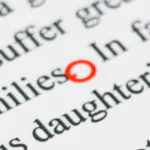
Proofreading Tips: Punctuation in MHRA Style
The MHRA Style Guide is often used in the humanities, especially in the UK. But what does a proofreader need to know when working on a document that follows this style? In this post, we will look at the rules for punctuation in MHRA style, including:
- General guidelines about the overall punctuation conventions in MHRA style.
- Some extra tips on stylistic quirks that can be easy to miss, including rules about commas, dashes, brackets and parentheses, and ellipses.
Read on for more about proofreading and punctuation in MHRA style.
Overall Punctuation Conventions in MHRA Style
Overall, MHRA style tends to follow UK punctuation rules. For instance:
- MHRA style recommends using ‘single quotation marks’ (not “double” ones).
- It only requires commas and full stops to be placed inside closing quotation marks when they are part of the quotation (whereas US-style always places them inside).
- It omits full stops at the end of abbreviations when the final letter of the abbreviation and the full word are the same (e.g., Mr, Mrs, Dr, Vols).
As a default, then, you will want to check for UK-style punctuation usage in your client’s work when they’re using MHRA style, with any US-style punctuation needing correction.
However, if your client is using another dialect, such as US English, they may decide to adjust the punctuation style to match. In this case, as long as the dialect and punctuation style fit the document, your main role as a proofreader will be to check for consistency.
Commas in MHRA Style
MHRA style follows standard rules for comma usage in most respects. However, it highlights three key usages that writers (and thus proofreaders) should be aware of:
- Setting apart parenthetical or interpolated phrases.
- Enclosing non-restrictive relative clauses.
- Using an Oxford or serial comma before the final item in lists (except in MHRA publications and titles/headings, where the final comma is optional).
These should all be standard for a proofreader. However, the MHRA Style Guide also says “commas should not be used if their omission leaves the meaning of the sentence unaffected.” As such, you may need to look out for excessive comma use when proofreading, though be careful not to remove commas that are needed for clarity.
En and Em Dashes in MHRA Style
MHRA style uses en dashes in two situations:
- To indicate a connection between two terms (e.g., US–UK relations).
- To show a range of figures or dates (e.g., 1990–1995).
Em dashes, meanwhile, are used to set apart information, either parenthetically or at the end of a sentence. In both cases, MHRA style usually spaces the dashes:
This book — her last — was to become her most famous.
This was her final book — it also became her most famous.
However, the MHRA Style Guide also says em dashes should be used sparingly in these situations, suggesting commas and parentheses for parenthetical statements. Extra detail at the end of a sentence, meanwhile, is usually introduced with a colon.
In addition, MHRA style uses a 2-em dash (i.e., two em dashes in succession) to prevent repetition of author names when an author has multiple sources in a bibliography:
Smith, Sarah, Dashing Punctuation (London: PA Books, 2018)
——, Hyphenate This! (New York: LI Publications, 2021)
If you see dashes in a document, then, make sure they follow these rules.
Parentheses and Brackets
MHRA style suggests distinct uses for parentheses (i.e., round brackets) and brackets (i.e., square brackets). In the main text of a document, the rules are:
- Parentheses should be used for parenthetical statements and in-text citations (although the latter is usually restricted to the author–date referencing style).
- Brackets should be used for additions and omissions in quoted text only.
Most notably, MHRA style permits nested parentheses (i.e., use of one set of round brackets within another set of round brackets). For example, the following would be fine:
The band maintained massive audience loyalty during their period of inactivity (this was confirmed when the reunion concert (1968) sold out in minutes).
Many style guides recommend square brackets for the nested ones in this type of situation. But with MHRA style, make sure your client uses parentheses for both sets.
Parentheses and brackets also have uses in MHRA style citations and references. The former are especially common, with several uses (e.g., enclosing publication information and pinpoint citations in footnote citations). But square brackets have just three:
- When reference details aren’t available in the cited source itself (e.g., if a book does not mention a date of publication but an archive lists its publication date, MHRA style would suggest giving the archive date in square brackets).
- For publications where the actual publication date was significantly after the official one (e.g., a journal volume where the publication was delayed).
- For dates that online sources were consulted (e.g., access dates for websites).
The first two here are quite rare situations, so it is mostly the last one you’ll need to look for when proofreading work that uses MHRA referencing. In addition, MHRA style suggests using angle brackets (i.e., < >) for URLs and DOIs in bibliography entries.
Ellipses in Quoted Material
When a writer omits something from a quote, MHRA style marks this with an ellipsis in square brackets (in line with the usage above about additions to quoted material):
Here, Sarah says, “I fought […] to take back what you have stolen.”
This distinguishes omissions from ellipses that are part of the text as written:
“But … that … that isn’t fair!” he said, haltingly.
If you’re not sure whether ellipses in a quotation indicate an omission or are from the original source, leave a note for your client asking them to check the usage.
Becoming A Proofreader
Our Becoming A Proofreader course includes an introduction to style guides and several major referencing styles, as well as all the professional skills required to proofread professionally. If you’d like to try the course for free, sign up for the trial version today!



Leave a Comment
Your email address will not be published.